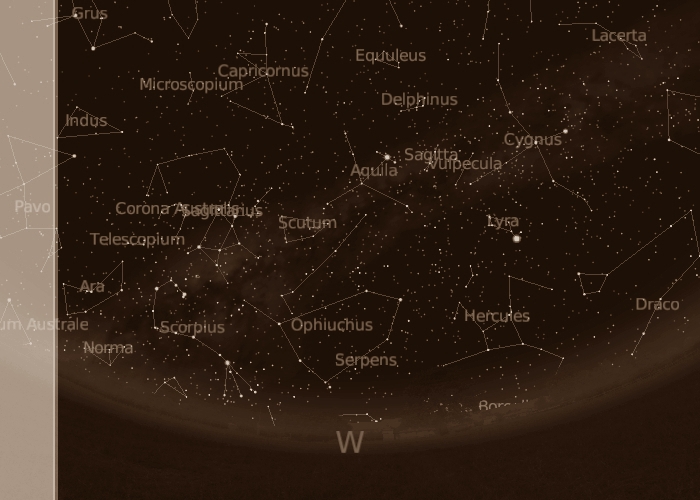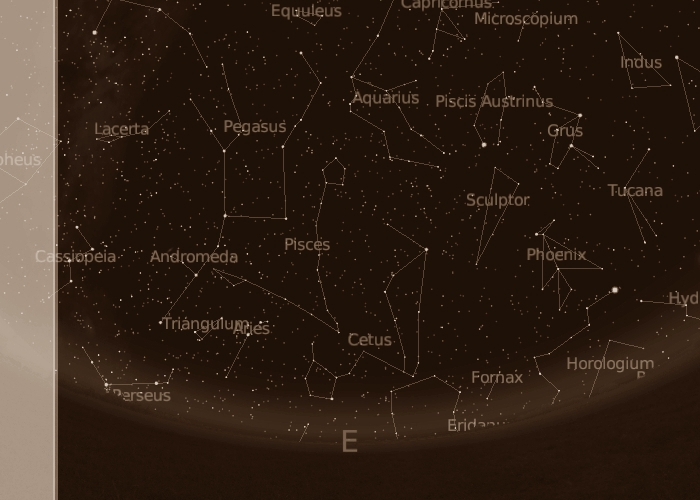Western Horizon
Eastern Horizon
Precisions About Daylight Saving Time (DST) Adjustments
![]()
Western Horizon
Eastern Horizon
Precisions About Daylight Saving Time (DST) Adjustments

We're seeing the skies of the summer solstice. The autumnal equinox however is occurring this month, hence that the sky we are seeing is a transitioning one, from a show mainly seen South and southwest to a ensemble of sky patches of interest. The embedded southern constellations in the Milky Way which are usually seen South-southwest in that season, has now much shifted West, with scorpius, the Scorpion, barely high. Sagittarius, the Archer, alone, is still high, as it's home to the center of our Milky Way Galaxy. As we are living inside our Galaxy, we can't see it under its form of such a large, spiral galaxy like the ones which were popularized by such pictures of the Andromeda or the Whirlpool Galaxies. We just see it under the form of the Milky Way, as it's in Sagittarius, that the bulge of old, yellowish stars is seen along with where the supermassive galactic black hole lies. The southern part of the sky is filled with small, typically southern constellations like Grus, the Crane, Phoenix, the Phoenix, or Indus, the Indian. Some bright stars which belong to those constellations are fine too in the neighbourhood, lile Fomalhaut, Alnair and the Peacok, as the much bright star, southeast, is the famed Achernar, there where Eridanus, the River Eridanus is ending its course! The Small Magellanic Cloud is another fine sight, as it will reach its best beginning next month. As Ophiuchus, the Serpent Holder and Hercules, the Heroe, are now tending much low West, the Summer Triangle is seen, high. The Summer Triangle is the distinctive feature of the summer nights in the northern hemisphere, as this vast triangle of stars is composed by the three, main stars of the constellations Aquila, the Eagle, Cygnus, the Swan, and Lyra, the Lyra. The topmost both stars are, from left to right Altair, of Aquila, and Deneb, of Cygnus, respectively, as the one below is Vega, of Lyra. to a printer-friendly chart
West for the mid-northern latitudes. West for the mid-southern latitudes

As the southeastern part of the sky is filled back with some regions of the small, typically southern constellations you saw South, Aquarius, the Water Bearer is much high -a field of possible interest- as it's a good time for some parts of Cetus, the Whale, which is lying below. The faint chain of Pisces, barely northeast, is another much fine sight, as the Circlet is high. The noticeable stars seen northeast are stars which belong to such constellations like Aries, the Ram, or Triangulum, the Triangle. A much fine sight too, albeit high somehow, is the Great Square of Pegasus, a fine and vast view, as the line of Andromeda, more accessible, is heading to the horizon. Cassiopeia is seen too. Andromeda, Andromeda is home to M31, the famed Andromeda Galaxy. The Andromeda Galaxy is a large spiral galaxy, which gives us a view of how our own Milky Way Galaxy would look, could we see it from the outside! At the 4.8th magnitude, M31 is a naked-eye object, and a fine binocular one. It's easy to find the galaxy, through an amusing star-hopping process! Just start at the lower left star of the Great Square of Pegasus, and find the first bright star on the line of Andromeda (the second on the line, that is). From there, slightly left, heads up to a fainter star, then a fainter star still, as the Andromeda Galaxy is lying there! Should you have an access to the northern horizon, some fine views are seen there, with Cepheus, Cepheus, North, parts of the Summer Triangle and Lacerta, the Lizzard above, and parts of Draco, the Dragon and Cassiopeia either side! to a printer-friendly chart
East for the mid-northern latitudes. East for the mid-southern latitudes
->Contrarily to what is seen in the northern hemisphere, or the southern, equatorial and tropical countries do not have any Daylight Saving Time (DST), as at these latitudes days are equaling nights all year long
Website Manager: G. Guichard, site 'Amateur Astronomy,' http://stars5.6te.net. Page Editor: G. Guichard. last edited: 12/28/2010. contact us at ggwebsites@outlook.com